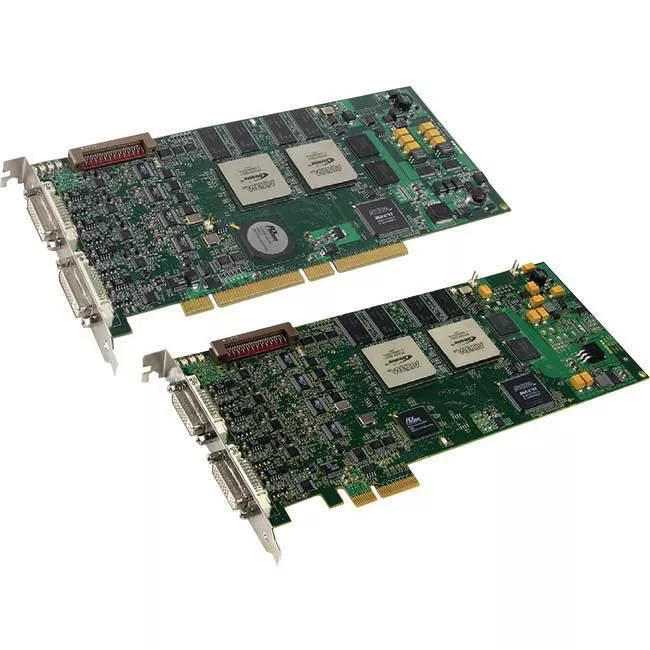
MPN: SOL 6M 4A*
Matrox SOL 6M 4A* Solios Analog PCI-X Frame Grabber
Highlights
About
Specifications
Cost-optimized and value-packed design
The Matrox Solios eA/XA frame grabber strikes a perfect balance between functionality and cost. Its high fidelity analog acquisition capabilities and high-performance PCI Express® (PCIe®) or PCI-X® bus interface make the Matrox Solios eA/XA a good match for mainstream cameras and the right choice for cost sensitive applications.
High fidelity analog acquisition
Matrox Solios eA/XA has up to four completely independent inputs for high fidelity video capture. In addition to being able to simultaneously acquire from up to four singleoutput video sources, the inputs can be combined to simultaneously acquire from two dual-output video sources or one RGB video source. Each input of the Matrox Solios eA/ XA features circuitry to monitor the presence of a video (synchronization) signal and status of the phase-locked loop. The Matrox Solios eA/XA can also transparently convert between monochrome and packed/planar RGB color spaces enabling the optimum representation of image data for processing and/or display.
Choice of high-performance bus interfaces
Four lane PCIe® (x4) and PCI-X® are the interfaces used to connect to the host PC on the Matrox Solios eA and Matrox Solios XA boards respectively. PCIe® is the follow-on to conventional PCI and PCI-X®. Version 1.x of PCIe® operates at 2.5 GHz to deliver a peak bandwidth of 1GB/sec over a x4 implementation. PCI-X® is a high-performance backwards-compatible enhancement to conventional PCI. Version 1.0a of PCI-X® specifies a 64-bit physical connection running at speeds of up to 133 MHz resulting in a peak bandwidth of up to 1 GB per second.
Field-proven application development software
Matrox Solios eA/XA is supported by the Matrox Imaging Library (MIL), a comprehensive collection of software tools for developing industrial imaging applications. MIL features interactive software and programming functions for image capture, processing, analysis, annotation, display and archiving. These tools are designed to enhance productivity, thereby reducing the time and effort required to bring your solution to market. Refer to the MIL datasheet for more information.
The Matrox Solios eA/XA frame grabber strikes a perfect balance between functionality and cost. Its high fidelity analog acquisition capabilities and high-performance PCI Express® (PCIe®) or PCI-X® bus interface make the Matrox Solios eA/XA a good match for mainstream cameras and the right choice for cost sensitive applications.
High fidelity analog acquisition
Matrox Solios eA/XA has up to four completely independent inputs for high fidelity video capture. In addition to being able to simultaneously acquire from up to four singleoutput video sources, the inputs can be combined to simultaneously acquire from two dual-output video sources or one RGB video source. Each input of the Matrox Solios eA/ XA features circuitry to monitor the presence of a video (synchronization) signal and status of the phase-locked loop. The Matrox Solios eA/XA can also transparently convert between monochrome and packed/planar RGB color spaces enabling the optimum representation of image data for processing and/or display.
Choice of high-performance bus interfaces
Four lane PCIe® (x4) and PCI-X® are the interfaces used to connect to the host PC on the Matrox Solios eA and Matrox Solios XA boards respectively. PCIe® is the follow-on to conventional PCI and PCI-X®. Version 1.x of PCIe® operates at 2.5 GHz to deliver a peak bandwidth of 1GB/sec over a x4 implementation. PCI-X® is a high-performance backwards-compatible enhancement to conventional PCI. Version 1.0a of PCI-X® specifies a 64-bit physical connection running at speeds of up to 133 MHz resulting in a peak bandwidth of up to 1 GB per second.
Field-proven application development software
Matrox Solios eA/XA is supported by the Matrox Imaging Library (MIL), a comprehensive collection of software tools for developing industrial imaging applications. MIL features interactive software and programming functions for image capture, processing, analysis, annotation, display and archiving. These tools are designed to enhance productivity, thereby reducing the time and effort required to bring your solution to market. Refer to the MIL datasheet for more information.

